SLF Quarantine in Two OH Counties
The Ohio Department of Agriculture (ODA) has imposed a spotted lanternfly quarantine on Jefferson and Cuyahoga Counties in eastern Ohio on October 28. The quarantine restricts movement of plant materials, equipment and other items from infested counties in Ohio and other states.
Individuals moving applicable items from the quarantined counties are asked to conduct a self-inspection for insects and eggs, and fill out a self-inspection checklist. Applicable items on the checklist include live or dead plants, and plant parts (including lumber and mulch), outdoor industrial and construction materials, equipment and waste, shipping and storage containers, outdoor household items, conveyances (cars, trucks, etc.), agricultural equipment, and children’s outdoor playthings. These are items that may be left outdoors for an extended period of time and may harbor egg masses.
Arborists, loggers, nursery growers and other plant industry professionals interested in moving certain products out of the quarantined counties as part of their commercial activities may need to be covered by a compliance agreement. Those interested in the compliance agreement are asked to contact ODA or call (614) 728-6400 for more information.
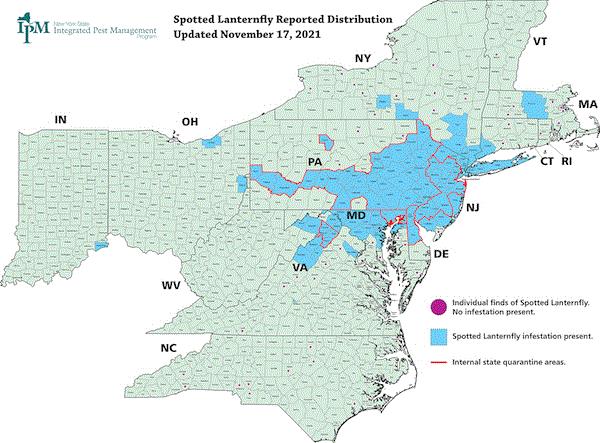
Distribution and quarantine zone of spotted lanternfly as of November 17. (Map credit: New York State IPM Program.)
There's no doubt that spotted lanternfly is spreading. The infestation was detected in Jefferson County in October 2020 and in Cuyahoga County in September 2021. The latest infestation was detected in Massachusetts. Currently, quarantine is imposed in several counties in Delaware, Maryland, New Jersey, Pennsylvania and Virginia. The New York State IPM website has lots of great spotted lanternfly information. Check it out.

USDA Uses Molecular Tools to Diagnose R3B2
Do y’all remember the detection of Ralstonia solanacearum race 3 biovar 2 (I called it R3B2 like a geek), a new cold-tolerant variant of the dangerous pathogen, in more than 650 greenhouses and its eventual eradication two months after detection last summer? No worries if you don’t; truth be told, I sort of forgot about it because there hasn’t been any new detection since then. That’s perhaps a testimonial to the effectiveness of the eradication program here and the certification program in offshore geranium propagation facilities.
If this new variant is ever established in the U.S., the disease will spell big trouble for the production of tomatoes and other crops. See an introduction to the disease in a June 2020 issue of this newsletter. Understandably USDA APHIS PPQ (Plant Protection and Quarantine) is extremely keen in making sure the disease is never introduced and established here.
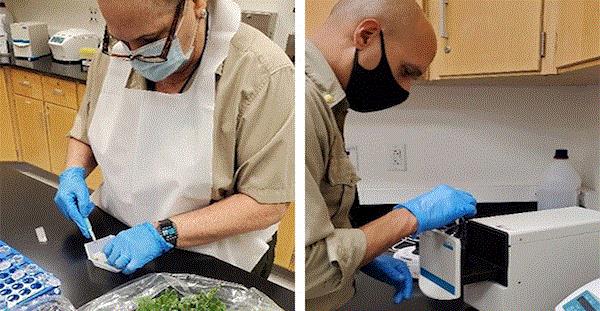
USDA APHIS PPQ officers diagnosing ralstonia R3B2 using the new MDx diagnostic equipment at the Miami Plant Inspection Station. (Photo credit: USDA APHIS PPQ.)
The cornerstone of USDA’s R3B2 program is a vigorous certification program at offshore facilities and inspection program at the ports of entry. USDA APHIS has deployed a new high-tech molecular diagnostic procedure, called MDx, to detect R3B2 on imported geranium cuttings at its plant inspection stations since late September. Click HERE for USDA’s announcement of the new procedure.
Although geranium cuttings produced at a certified offshore propagation facility should be free of the pathogen, the molecular diagnostic procedure provides an added layer of certainty to the cuttings being free of R3B2. Samples will be randomly selected from shipments from each certified facility to receive additional molecular diagnostics. The shipment tested in late September, from Guatemala and Mexico, were found to have no R3B2.

USDA Deploys New Predictive Tool
In addition to detecting the potential entry of dangerous insects and diseases, USDA APHIS PPQ is also interested in knowing what has the potential of being introduced (pathway and risk prediction) and predicting how widely an invasive pest may spread, and what kind of economic impacts it may have once it's established.
USDA APHIS PPQ recently organized a group of experts in quantitative analysis—called the Phytosanitary Advanced Analytics Team (PAAT)—to, in USDA’s words, “turn data into insights.” PAAT works with researchers at North Carolina State University and develops the Pest or Pathogen Spread (PoPS) simulation model where the spread of invasive pests and diseases could be predicted and displayed. Variables used in the simulation come from field and laboratory studies or activities, including but not limited to: detection and distribution data from surveys, host distribution, environmental data, management activities, etc.

A demo run of PoPS based on spotted lanternfly distribution and management data in Pittsburg, Pennsylvania. (Photo credit: USDA APHIS PPQ.)
The team demonstrated the capability of the model by predicting the spread of spotted lanternfly (above). Users of the model can input different variables, such as changing different treatment scenarios and areas, to predict the spread of the pest and answer the questions of how effective various management scenarios may be.
Devon Geydos, the project’s lead PAAT analyst said, “With PoPS, decision-makers can iteratively explore what-if scenarios. What if we use a different treatment? What if we treat different locations? What if our budget changes? PoPS can help answer these questions in a risk-free, simulation environment.”

A Pesticide Bill to be Introduced in Congress
I’m highly allergic to politics. I avoid it like pollen in the spring. As a result, I don’t talk about politics and policy-making on this newsletter. But there's always the first time and let today be noted as the first time.
Politico reported that Senator Cory Booker (D–NJ) is expected to introduce two bills this week. The first bill is co-sponsored with Representative Ro Khanna (D-CA) and dubbed the Protecting America’s Meatpacking Workers Act.
The second bill aims to ban three major groups of pesticides—namely organophosphates, neonicotinoids and paraquat—today. The first two are commonly used insecticides and the latter an herbicide.
Dubbed the Protect America’s Children From Toxic Pesticides Act, this bill is largely the same to an identically named bill introduced in the House by Representative Joe Neguse (D-CO) and in the Senate by then-Senator Tom Udall (D-NM) in 2020. The previous version didn’t receive a vote in the 116th Congress in 2020.
The bill aims to amend the Federal Insecticide, Fungicide and Rodenticide Act, and to ban the aforementioned pesticides from use. New language is inserted in the soon-to-be-introduced version to protect farmworkers from retaliation if they speak out and to expand the ability of citizens to pursue legal actions if EPA doesn’t fully enforce the law.
Will this bill be considered and passed by Congress? We’ll have to wait and see. According to Politico, Senator Booker hopes the Biden administration will adopt some proposals that don't need congressional approval and aims to include portions of the two bills in the next Farm Bill.

Watch Where You Sit
I’ll close this week’s newsletter with a friendly reminder: Watch where you sit.
Y’all probably don’t have to worry about the danger of sitting on or near some stinging insects if you live somewhere that’s already under feet of snow or inches of frost. Palmy days and bugs abound along the coast of South Carolina. I found this little one on the cushion of a porch chair I was about to sit on to watch the ebbing tide while having a little bourbon. Instead of being proud of myself for taking some time to enjoy life I would have been very sorry because a puss caterpillar was laying in wait where I would have put my bare neck.
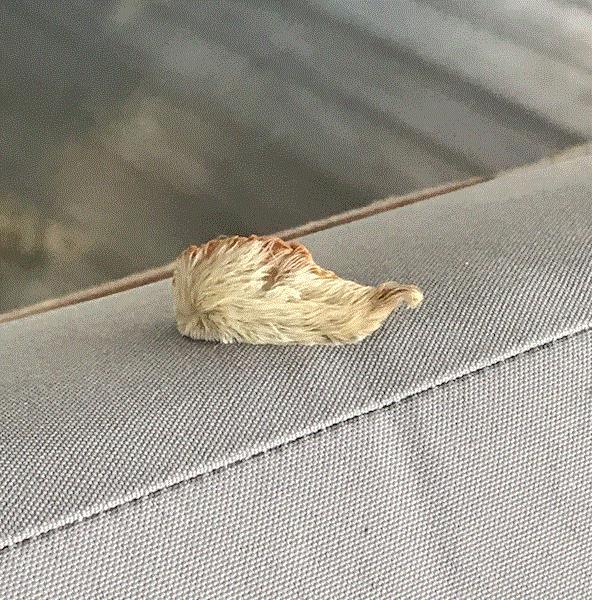
There are quite a few stinging caterpillar species in South Carolina, including the saddleback caterpillar, puss caterpillar and other hairy ones. My colleagues at Clemson University—Pat Zungoli and Eric Benson, and their student Aaron Hagerty—wrote a short introduction to several common stinging caterpillar species in South Carolina. Just about every state extension service has a similar fact sheet. Check out these extension publications if you're interested in being acquainted with the stinging caterpillars around you, even if it's through a computer monitor screen.
Puss caterpillar is full of urticating hairs and may not look that impressive. They move slowly (really, I dare anyone to mess with them because of their sluggish look) and have two to three generations in the South. The adult, commonly known as the southern flannel moth, is a serious beauty. Check out this excellent fact sheet about the southern flannel moth by Donald Hall at the University of Florida. I’ve learned so much about this unassuming species from this article.
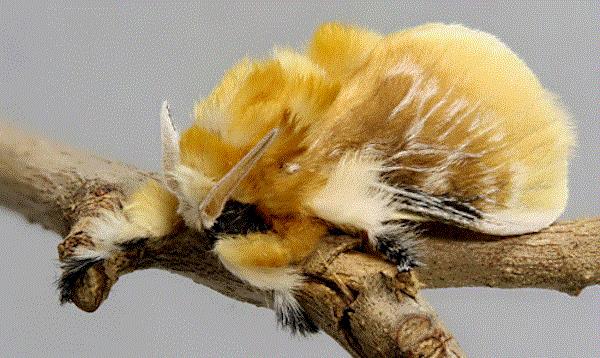
A southern flannel moth or the adult of a puss caterpillar. (Photo credit: Donald Hall, University of Florida.)
I have the good fortune of having avoided puss caterpillar stings my entire life. Can’t say that much about saddleback caterpillar, which I encounter frequently during my forays into the woods. The hour-long burning sensation and sharp pain from saddleback caterpillar is no joke. If you ever get stung, try to lift as much of the hairs off with strong adhesive tape (such as Duct tape or masking tape) and wash the skin with water and soap. An ice pack on the affected area can help reduce pain and swelling, so does hydrocortisone cream. If it gets pretty bad, it’s best checking in with your physician. The best thing to do? Watch where you put your bare hands or neck!
You know which fuzzy dangerous-looking caterpillar won’t give you the itch? I’m looking at you, woolly bear!
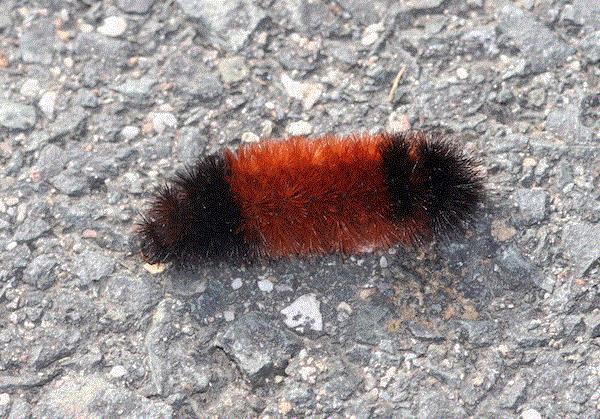
A woolly bear caterpillar doesn't give you the itch. (Photo credit: Debbie Johnson, University of Missouri.)




Happy Thanksgiving!

JC Chong
Professor of Entomology at Clemson University
This e-mail received by 26,766 subscribers like you!
If you're interested in advertising on PestTalks contact Kim Brown ASAP!